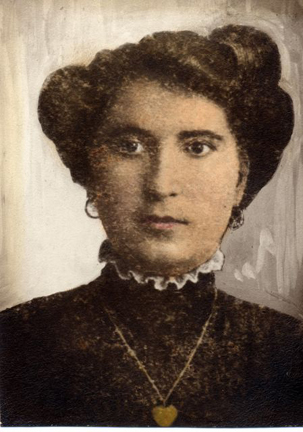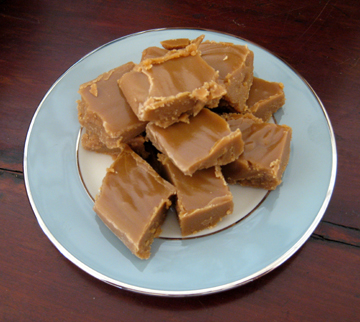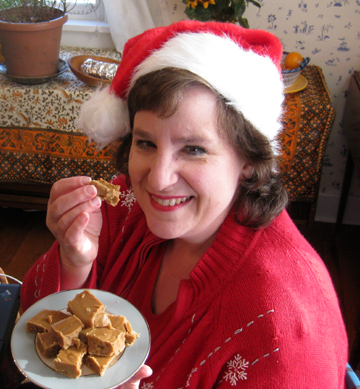
One of the reasons that I love my mixed religious heritage (my mother is Christian, and my father was Jewish) is that I have extra holidays to celebrate.
I particularly enjoy the two traditions’ far apart and very different new-year markers.
The Christian New Year, just beyond the winter solstice, provides hope that spring will come, always a cheerful thought when it’s chilly outside. It gives us an excuse to light up the house on a dark winter night, to prepare something warm like onion soup or oysters, and to share wishes for the future with friends.
The Jewish New Year carries with it more religious importance than its Christian counterpart. It also feels newer. It falls in autumn, when we traditionally embark on new enterprises—school, diets, blogs (well, my blog, at any rate). Stretching out over ten days, it gives people time to get in touch with friends and family, to mull over the good and bad parts of the past year, and to get ready for the future. It is both introspective and social, somber and joyful.
Visiting my grandparents on Long Island for the High Holy Days was one of the highlights of my childhood. I loved sitting in the upper level of the Temple with my grandmother on Rosh Hashanah. The women kept track of what was going on downstairs, where the men (including my grandfather) went about the business of the shul.

My Grandfather, William (originally "Wolf") Weisblat (Courtesy of Bob Kraut)
The women also quietly gossiped and wished each other a happy new year, conducting their own social services to complement the religious ones below.
My grandmother was one of the social leaders of her community. I don’t mean that she was elegant or a trendsetter. She represented something far more valuable than either of those characteristics–a person to whom her neighbors turned for advice, for a friendly ear, for her large brain and heart. My family tells me that I look like her, and that I’m bossy like her. (I prefer such terms are assertive and knowledgeable.) I’d like to think that I have a little of her skill with people as well.

My Grandmother, Sarah Hiller Weisblat, in Her Youth (Courtesy of Bob Kraut)
Whenever the Jewish New Year comes around, I like to remember my grandparents and their family with honey, a culinary highlight of this holiday. In the Jewish tradition, food is always more than just food. It’s a symbol of relationships and shared heritage. When we give our friends and relatives honey cake, we hope the gift brings them a sweet new year figuratively as well as literally.

- William and Sarah’s Children–Benny, Selma, and (the baby, my dad!) Abe (Courtesy of Bob Kraut)
The recipe below comes from Micheale Battles, a busy attorney in the D.C. area who still finds time for cooking, family, and religious traditions. Her extended Passover Seder is legendary in northern Virginia. Michaele’s honey cake is called friendship cake because it makes two cakes—one to keep, and one to share with a friend. Michaele ALWAYS puts in the nuts, but I like the cake without them as well so I made them optional in my version of her recipe. The cake itself is dense and flavorful and tastes even better with a little fruit. The coffee in the recipe cuts the honey and makes the flavor subtle.
Michaele’s Rosh Hashanah Friendship Honey Cake
Ingredients:
1 pound honey (1-1/3 cups, according to my friends at Warm Colors Apiary)
1-1/4 cups sugar
1/2 cup shortening of your choice (I used butter since I don’t keep Kosher!)
5 eggs, separated
3 cups flour, sifted
1 tablespoon baking powder
1-1/2 teaspoons cinnamon or to taste
1/2 cup black coffee
1 teaspoon baking soda, dissolved in the coffee
2 teaspoons vanilla
1 cup chopped walnuts or toasted pecans (optional)
Instructions:
Preheat the oven to 350 degrees. Generously grease 2 loaf pans.
Cream together the honey, sugar, and shortening. Add the egg yolks, and mix well.
Stir together the flour, baking powder, and cinnamon. Add them to the honey mixture, alternating with the coffee/baking soda solution. Add the vanilla and the nuts (if you’re using them).
Beat the egg whites just until they hold a peak, and fold them into the batter. Pour the batter into the prepared pans.
Bake for 1 hour (or a little less), or until a toothpick inserted into the middle of the cakes comes out dry. Begin looking at the cakes after 40 minutes.
If they look brown on the outside but are wet on the inside, turn the oven down to 300 degrees, and continue checking every 5 minutes until the toothpick test works.
Let the cakes cool in their pans for 20 minutes;then gently loosen them with a knife or a spatula, and slide them onto a rack to finish cooling. Makes 2 loaves.








